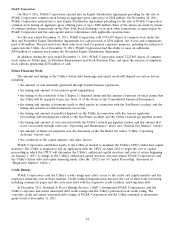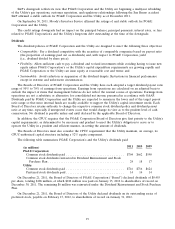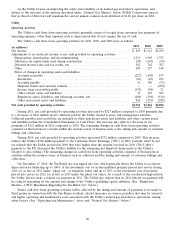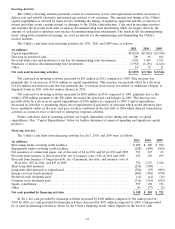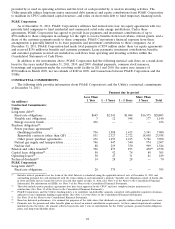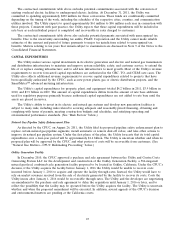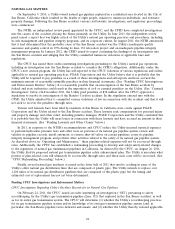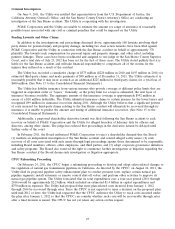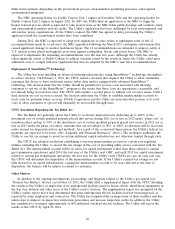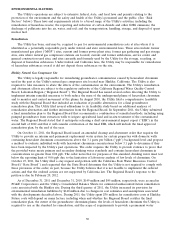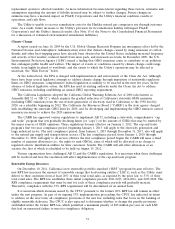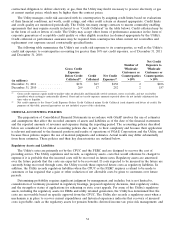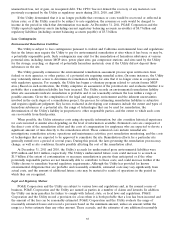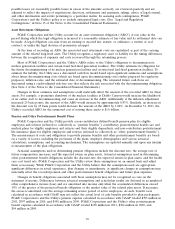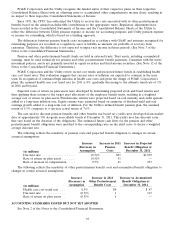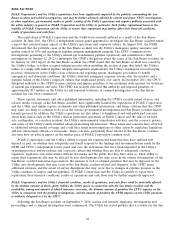PG&E 2011 Annual Report Download - page 32
Download and view the complete annual report
Please find page 32 of the 2011 PG&E annual report below. You can navigate through the pages in the report by either clicking on the pages listed below, or by using the keyword search tool below to find specific information within the annual report.On January 13, 2012, the Utility filed its response to recommendations made by the CPSD on the proposed
plan. The Utility agreed with most of the CPSD’s 16 recommendations, including a recommendation that the Utility
not recover through rates the costs it incurs to conduct pressure tests on pipelines installed generally between 1961
and 1970 if certain documentation is missing. Consequently, the Utility expects that the costs for these pressure tests
will be borne by shareholders, as recommended by the CPSD, instead of by ratepayers as the Utility had originally
proposed. The Utility has objected to the CPSD’s recommendation that the Utility not seek rate recovery of certain
costs to implement changes and enhancements to the Utility’s pipeline records management process and to develop a
new system to manage gas transmission assets. On January 31, 2012, the CPUC’s Division of Ratepayer Advocates,
The Utility Reform Network, and other parties filed their comments on the Utility’s proposed plan. They have made
various recommendations addressing cost recovery and ratemaking issues, including recommendations that the Utility
be prohibited from recovering all or a portion of plan-related costs through rates and that the Utility’s rate of return
on any authorized capital expenditures be reduced or limited to the costs of debt. The Utility’s rebuttal testimony is
due on February 28, 2012 and evidentiary hearings are scheduled to commence on March 12, 2012 for two weeks.
As discussed in ‘‘Operating and Maintenance’’ above, during 2011, the Utility has incurred incremental pipeline-
related costs of $483 million in operating and maintenance expense that will not be recoverable from customers
through rates. The Utility forecasts that it will incur costs associated with its natural gas pipeline system ranging from
$450 million to $550 million in 2012, which may not be recoverable from customers. The ultimate amount of
pipeline-related costs that are recoverable from customers will depend on various factors, including when and
whether the CPUC takes action on the Utility’s recovery request above, the scope and timing of the work to be
performed under the Utility’s pipeline safety enhancement plan as approved by the CPUC, the amount of costs to
perform work under the plan that the CPUC determines the Utility may not recover through rates, whether the
CPUC adopts the financial recommendations made by the CPSD as discussed above, and whether additional costs
are incurred to comply with new regulatory and legislative requirements.
Finally, the CPUC has not yet acted on the proposed stipulation to resolve an order to show cause that the
CPUC issued on March 24, 2011 to require the Utility to show why it should not be penalized for failing to present
evidence that it ‘‘aggressively and diligently searched’’ its pipeline records as previously ordered. On February 3,
2012, the Utility and the CPSD filed a joint status report stating that the Utility had completed the compliance plan
agreed to in the stipulation resolving the order to show cause on time, that the Utility should pay the agreed
$3 million penalty, and that the proceeding should be closed.
REGULATORY MATTERS
The Utility is subject to substantial regulation by the CPUC, the FERC, the NRC and other federal and state
regulatory agencies. The resolutions of these and other proceedings may affect PG&E Corporation’s and the Utility’s
results of operations and financial condition. As soon as July 2012, the Utility may file a notice of intent with the
CPUC that will include a draft of the Utility’s GRC application for the period beginning January 1, 2014. The
Utility’s GRC application is planned for December 2012.
2012 Cost of Capital Proceeding
The CPUC authorizes the Utility’s capital structure (i.e., the relative weightings of common equity, preferred
equity, and debt) and the authorized rates of return on each component that the Utility may earn on its electric and
natural gas distribution and electric generation assets. The current authorized capital structure consisting of 52%
equity, 46% long-term debt, and 2% preferred stock will remain in effect through 2012. California utilities are
required to file their applications with the CPUC in April 2012 to begin the cost of capital proceeding in which the
CPUC will determine the utilities’ authorized capital structure and rates of return beginning on January 1, 2013.
Diablo Canyon Nuclear Power Plant
In 2010, the Utility began to conduct extensive seismological studies of the area at and surrounding the Utility’s
Diablo Canyon nuclear power plant located in San Luis Obispo, California, a seismically active region, as had been
recommended by the California Energy Commission. The CPUC authorized the Utility to recover estimated costs of
approximately $17 million to conduct these studies. The Utility’s current estimate of the remaining costs to conduct
the studies has increased, primarily because the studies will encompass a greater geographic area than originally
planned, and the Utility has requested that the CPUC authorize the Utility to recover an additional $47 million. The
Utility expects that the studies will not be completed until 2014 or 2015. The Utility is uncertain when the CPUC will
act on this request and what portion of these estimated costs will be recoverable through rates. Actual costs may
28


